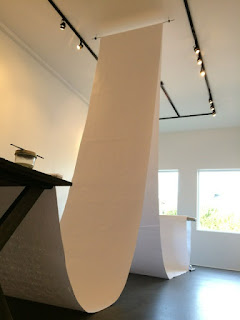Photo:
Socially conscious art at Feast Art Center by Alec Clayton
Published in the Weekly Volcano, Jan. 26, 2017
 |
| Anne de Marcken (with hand on hip) talking to gallery visitors, photo by Natasha Marin. |
Anne de Marcken, whose stunning Redaction
Project at Salon Refu this past spring I reviewed in this column, is at it
again with another intriguing, intelligent and engaging art project. This time
it is what she calls a “performative piece” at the Feast Art Center.
This project defies easy categorization. It is not exactly visual art,
but it is in a gallery, and there is a strong visual element. It might be
called an installation or a happening — who is old enough to remember
happenings? — or a social experiment designed to help people meet their real needs.
To explain, I must first introduce conceptual artist Natasha Marin and
audio artist Mattilda Bernstein Sycamore, both of
whom collaborated with de Marcken on the project. Sycamore’s Reparations project began as a movement
on Facebook where she wrote: “I invite People of Color to ask for what we need
to feel better, be happier, be more productive by posting in this space. ... I
invite people who identify as White to offer services or contributions to
People of Color in need of time, energy, substantive care, and support."
In the gallery, de Marcken copies onto a 1,000-foot-long
sheet of butcher paper word-for-word in invisible ink (lemon juice) the
requests People of Color have sent in to the Reparations project.
The butcher paper hangs from a rod attached to the gallery
ceiling, across a work table on one end of the gallery and onto an ironing
board at the other end. De Marcken irons across the invisible ink, which then
becomes visible. Finally, she posts the requests on the white walls of the
gallery where White people can take them down, take them home, and fulfill the
requests in whatever manner they may.
Examples of the requests are : “…rent is still a struggle.
We had to do a payday loan and overdraft our bank account to pay chunks of our
bills this month. Now my car is making a funny noise …” and “We can’t find a
safe clean place to raise our baby; they keep trying to rent us condemned
places.”
Visually and symbolically it is an installation in white
on white with invisible ink and with the subjects of the requests being
invisible as in Ralph Ellison’s Invisible
Man.
“Writing with lemon juice (homemade invisible ink) on white paper turns
out to be incredibly arduous: like the effort to see one’s own privilege or to
make one’s own vulnerability seen,” says de Marcken. “It is also basic,
magical, and almost impossible to perfect.”
The gallery describes the piece as “a
1000-foot-long enunciation of the ways whiteness protects those affiliated with
its power from awareness of and accountability for the costs and benefits of
that artificial construction. Participants are invited to iron out the lemon
juice messages, enacting the process of making need and harm visible…and are
then invited to go further: to take simple actions to meet need and remedy harm
by responding materially to the original messages.”
During open hours a two-track audio plays, simultaneously, sound bites from Hillary Clinton speaking to a reporter at Nancy Reagan’s funeral and Barack Obama speaking at a memorial service for the five police officers killed in Dallas, Tex.
During open hours a two-track audio plays, simultaneously, sound bites from Hillary Clinton speaking to a reporter at Nancy Reagan’s funeral and Barack Obama speaking at a memorial service for the five police officers killed in Dallas, Tex.
De Marcken, who teaches writing at The Evergreen State College, also
teaches writing workshops at the Feast Center. She will be teaching from 2-4
p.m. Saturday, Jan. 28 and Feb. 4.
Invisible Ink, noon to 5 p.m. Saturday, 9 a.m. to 1 p.m. Sunday, and by appointment,
through Feb. 11, Feast Arts Center, 1402 S. 11th
St., Tacoma, www.feastarts.com


No comments:
Post a Comment